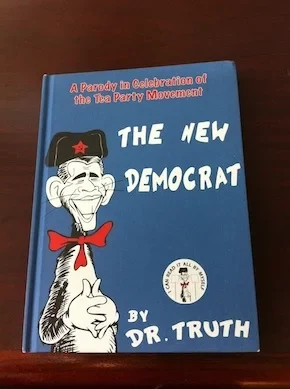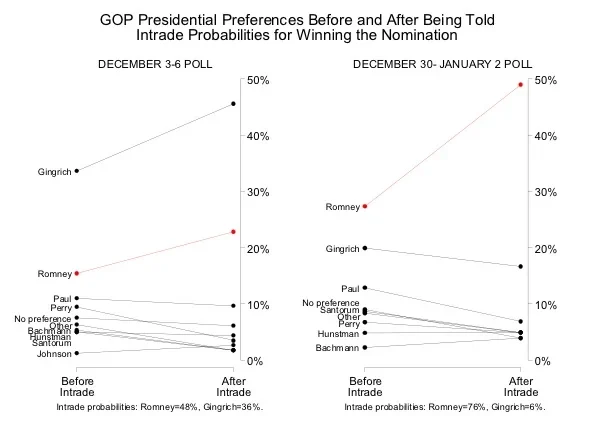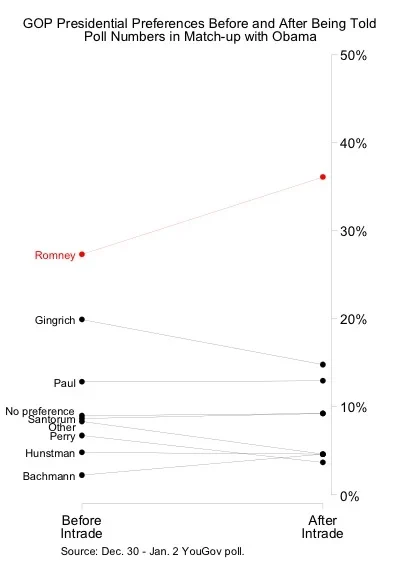At a Santorum event in Altoona, Iowa, Sides was approached by a man selling a book he had written:

It is a retelling of The Cat in the Hat, starring Barack Obama as “The New Democrat.” The illustrations resemble the Seussian originals, although the verses differ slightly. To wit:
They’ll do us no harm...
If they see we are weak
We must therefore disarm!
Sides asked the author, Loren Spivack, who he was supporting in the Republican primary. He said either Santorum or Perry (“definitely one of the Ricks”). Then Sides asked if he would vote for Romney if Romney were the nominee. He paused a moment, shrugged, and said “Yeah.” His tone suggested that there wouldn’t be any other option.
In a divisive partisan primary, it’s easy to think that supporters of the various candidates are loyal only to that candidate. But this conversation in Iowa belies an important point: the preferences of many primary voters can change and they do change. Maybe they’ll come around to a candidate because anyone is better than the opponent. For example, someone who writes a book that features Obama wearing a hat with a hammer and sickle decal probably won’t vote for Obama.
Voters might also change their minds in a primary election because they consider not only a candidate’s biography and beliefs, but also how likely they are to win. Political scientists conceptualize this likelihood in two ways: viability refers to the candidate’s ability to win the nomination, and electability refers to the candidate’s ability to win the general election. Perceptions of viability and electability are correlated with preferences among presidential candidates, but it is harder to determine whether any correlation is truly causal. After all, maybe voters decide to support a candidate, and then simply tell themselves that their candidate is likely to win.
In our early December study, we evaded this problem by randomly assigning respondents to receive information about each candidate’s chances of winning the nomination, winning the general election, or both. This information came from the betting market Intrade. Overall, about 35% of Republican respondents changed their minds. Information about the nomination (viability) helped the two candidates leading in the polls at that point: Romney and Gingrich. But information about the general election (electability) primarily helped Romney.
Now fast-forward to the end of December. Gingrich’s star had fallen. The Santorum surge had just begun. Romney seemed more in command. How would similar information about viability and electability matter now? It’s possible that it might not matter at all. By this point, voters might have learned all they needed to know about who had the best chance of winning either the nomination or the presidency. Or it might matter, but work only to Romney’s advantage, since he was favored to win the nomination and was perhaps best-positioned to run against Obama.
In a December 31 – January 2 YouGov poll, fielded before the Iowa caucus, we conducted a similar experiment. Republican respondents had been asked their candidate preference early in the poll. Later they were randomly assigned to see information about the candidates’ chances of winning the nomination and/or the general election, and then asked their preference a second time.
The nomination chances again came from Intrade. At the time when the poll was fielded, Romney was given a 76.3% chance of winning. No other candidate was close. For example, Gingrich was at 5.7%, Paul was at 3.0%, and Santorum was at 2.9%. This information should lead some voters to switch their vote to Romney.
The general election information was different than in the earlier experiment. Here, rather than Intrade probabilities, we presented respondents with information about how well the Republican candidates would do against Barack Obama in a head-to-head match-up. We gleaned this information from recent polling data: Pollster’s trends for Obama vs. Romney and Gingrich, as well as Rasmussen and Public Policy Polling surveys. In essence, these numbers tell voters how well each candidate would do against Obama—at least at that moment—if that candidate became the nominee. Respondents who received this information saw the following:
Recent polls suggest that, in a head-to-head match-up with Barack Obama, these Republican candidates would win the following percentage of the vote.
| Name | % of vote |
|---|---|
Romney | 49% |
Gingrich | 45% |
Paul | 47% |
Huntsman | 47% |
Perry | 44% |
Bachmann | 44% |
Santorum | 45% |
Just as in the earlier survey, many Republicans in this poll—26%—changed their preference when confronted with information about viability, electability, or both. This is a smaller fraction than in the earlier survey (35%), perhaps because people’s preferences had grown more crystallized and resistant to change over the month. Or perhaps people had begun to assimilate other information about viability and electability, rendering the experimental treatments less potent.
To examine how the treatments may have mattered, we begin with respondents who received only information about primary chances. Here are its effects in both the early and late December polls:

In both cases, this information boosted candidates who had a decent chance of winning the nomination: Gingrich and Romney in the earlier poll, but only Romney in the later poll. And the higher the Intrade probability, the bigger the boost. Given that the Intrade numbers benefit the leading candidate or candidates even though Gingrich is supposedly more conservative than Romney, it suggests that concerns about viability may trump ideology—at least for some voters.
What about the general election information? We focus on the second experiment, which presented the polling numbers from match-ups with Obama.

Here again, Romney benefits. His projected performance against Obama is the best of any candidate (49%) and he is the only one who benefits from providing respondents this poll number. His vote share increases from 27% to 36%. Interestingly, however, the 36% figure is actually lower than was his support among respondents shown only his chance of winning the primary (49%; see the first figure). This could be because the polling numbers were somewhat more equivocal: only 5 points separated Romney from the Republican who is predicted to perform the worst against Obama (Bachmann, at 44%).
Among respondents shown both the primary and general election information, Romney is again the only candidate who really benefits. His vote share increases to 43% from the original 27%.
The two experiments we’ve conducted demonstrate that Republican voters will change their minds when forced to consider both viability and electability. And as of the eve of the Iowa caucus, voters who do change their mind shift to Romney.
This calls into question the oft-repeated notion that 75% of Republican simply won’t vote for Romney. Our results suggest that a vote for a candidate besides Romney is not necessarily a vote against Romney.
Whatever his limitations or liabilities among the Republican electorate, the juggernaut of his nomination campaign, combined with his chances against Obama in November, make him attractive—perhaps even to voters inspired by Glenn Beck.










